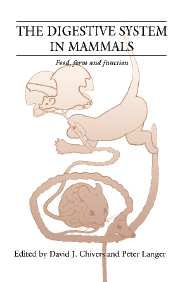Book contents
- Frontmatter
- Contents
- List of contributors
- Preface
- Part I Introduction
- Part II Food
- Part III Form
- Part IV Function
- 18 Foraging and digestion in herbivores
- 19 Gut morphology, body size and digestive performance in rodents
- 20 The integrated processing response in herbivorous small mammals
- 21 Digestive constraints on dietary scope in small and moderately-small mammals: how much do we really understand?
- 22 The effects and costs of allelochemicals for mammalian herbivores: an ecological perspective
- 23 Short-chain fatty acids as a physiological signal from gut microbes
- Part V Synthesis and perspectives
- Index
21 - Digestive constraints on dietary scope in small and moderately-small mammals: how much do we really understand?
Published online by Cambridge University Press: 18 March 2010
- Frontmatter
- Contents
- List of contributors
- Preface
- Part I Introduction
- Part II Food
- Part III Form
- Part IV Function
- 18 Foraging and digestion in herbivores
- 19 Gut morphology, body size and digestive performance in rodents
- 20 The integrated processing response in herbivorous small mammals
- 21 Digestive constraints on dietary scope in small and moderately-small mammals: how much do we really understand?
- 22 The effects and costs of allelochemicals for mammalian herbivores: an ecological perspective
- 23 Short-chain fatty acids as a physiological signal from gut microbes
- Part V Synthesis and perspectives
- Index
Summary
With decreasing body mass among mammals, the proportion of species eating fibrous plant tissues declines and the proportion selecting low-fibre plant and animal tissues increases (Bell, 1969; Jarman, 1974; Clutton-Brock and Harvey, 1977; Hume, 1984; Hofmann, 1989). The trend is clear among all groups of mammals (see discussion below), but the most comprehensive evidence for it comes from studies of wild ruminants (Bell, 1969; Jarman, 1974; Hofmann, 1989). This is because ruminants are among the most visible and abundant of mammalian herbivores and have been intensively studied due to their potential for domestication. Explanations for the decline in fibre-feeding with decreasing body mass among ruminants have been postulated in recent years, based on empirical and mechanistic models of energy yield from fermentative digestion of fibre and the unequal allometries of energy requirements and fermentation capacity (Parra, 1978; Demment and van Soest, 1985). These models are based on data from medium and large species and predict strong constraints on fermentative use of fibrous diets at body masses less than about 10–20 kg. However, this concentration on ruminants, the smallest of which is about 3 kg body mass, limits extrapolation of the models to predict or explain feeding constraints in other mammals, especially small species and those with digestive strategies not based on foregut fermentation. I show in this chapter that most current ruminant-based models make few or no useful predictions about constraints on fibre-utilisation in small non-ruminant herbivores.
- Type
- Chapter
- Information
- The Digestive System in MammalsFood Form and Function, pp. 337 - 369Publisher: Cambridge University PressPrint publication year: 1994
- 18
- Cited by



